Predictive analytics for healthcare is quietly becoming one of the smartest plays in health tech.
It's not just about data - it's about turning data into foresight.
From predicting ICU needs to identifying chronic illness risks early, this tech is already saving lives and costs.
The role of predictive analytics and healthcare is shifting from "experimental" to "essential."
Hospitals aren't waiting - they're integrating it now.
There are real examples of predictive healthcare in healthcare, and real returns for investors.
This is where AI meets ROI.
Think: fewer readmissions, more innovative staffing, faster decisions.
It's precision care, powered by patterns.
And investors who move early?
They're not just backing apps - they’re backing the future of medicine.
Overview of Predictive Analytics in Healthcare
Let’s be honest- healthcare hasn't always been known for being ahead of the tech curve. But that’s changing fast.
Predictive analytics in healthcare is flipping the script- turning messy, overwhelming patient data into smart, actionable insights.
And we’re not talking about vague predictions. We’re talking about tech that can flag a patient likely to have complications before symptoms show up.
Or software that helps hospitals prep for a surge in ER visits days in advance.
It’s like healthcare finally got its own crystal ball, and it’s powered by real-time data, machine learning, and serious computing power.
Whether it’s used to reduce readmissions, detect chronic illness early, or just make hospital operations smoother, predictive analytics in healthcare is quickly becoming the industry’s most underrated superhero.
Growing Market of Predictive Analytics

The predictive analytics software market, valued at $5.29 billion in 2020, is projected to soar to $41.52 billion by 2028. It's widely used to understand consumer behavior, streamline supply chains, and optimize business operations.
This is why many businesses are now eager to create a healthcare app that integrates predictive analytics, aiming to deliver smarter, data-driven care and improve overall patient outcomes.
Unlocking the Benefits of Predictive Analytics in Healthcare
Healthcare is shifting from reactive to proactive, and predictive analytics is at the core of that transformation.
By combining big data and predictive analytics in healthcare, organizations are moving beyond treating symptoms to anticipating risks.
Partnering with the best mobile app development company ensures seamless integration of these predictive tools into clinical workflows, streamlining operations and delivering more personalized care.
Here are some benefits of predictive analytics in healthcare that are actually changing how care gets delivered:
-
- Early detection of high-risk patients- Spot potential complications before they escalate - whether it's sepsis, cardiac issues, or chronic disease flare-ups.
- Data-driven care decisions- Clinicians can access insights in real time, supporting faster, more accurate diagnoses and treatment plans.
- Optimized resource allocation- Forecast patient inflow, adjust staffing, and manage equipment better, all with predictive data.
- Fewer hospital readmissions- Use data patterns to understand why patients return, and fix the gaps before they happen.
- Improved chronic disease management- Predict patient behavior and health trends to deliver ongoing, adaptive care for diabetes, hypertension, and more.
- Lower operational costs- Predictive analytics reduces inefficiencies, unnecessary tests, and administrative overload.
- Safer medication use- Identify patients at risk of adverse drug reactions based on history and real-time data patterns.
- Public health forecasting- Predict outbreaks, monitor population trends, and improve emergency preparedness on a regional or national scale.
The benefits of predictive analytics in healthcare go far beyond buzzwords- they're driving real impact, measurable ROI, and a smarter future for care systems.
Key Use Cases of Predictive Analytics in Healthcare
Let us take a moment to say predictive analytics in healthcare has already begun to transform how we approach patient care, operational efficiency, and overall health system performance.
By leveraging vast amounts of data, predictive analytics helps healthcare professionals not only respond faster but also anticipate problems before they occur.
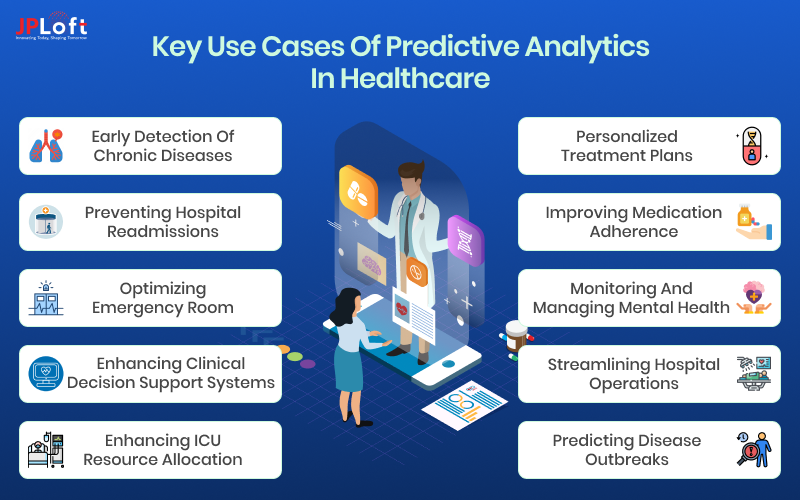
Let’s dive into ten predictive analytics in healthcare examples that are driving change across the industry.
1. Early Detection of Chronic Diseases
One of the most valuable benefits of predictive analytics for healthcare is its power to detect chronic illnesses, like diabetes, hypertension, or cardiovascular disease, far earlier than conventional screening.
By analyzing EHRs, genetic data, and behavioral patterns, healthcare predictive analytics helps physicians pinpoint individuals at high risk even before symptoms show.
This enables timely intervention, improving long-term outcomes and reducing the need for emergency care.
Why it matters:
-
- Nearly 60% of U.S. adults have at least one chronic illness (CDC).
- Early detection reduces hospitalization rates by up to 30%.
The impact of predictive analytics in healthcare in this area is massive, cutting future costs, improving patient longevity, and boosting clinical efficiency.
2. Preventing Hospital Readmissions
Reducing readmissions is not just a quality metric; it’s a financial and care delivery priority.
Predictive analytics for healthcare enables hospitals to anticipate which patients are most likely to return within 30 days post-discharge.
By studying patient history, comorbidities, discharge plans, and socio-economic data, providers can personalize aftercare, improving outcomes and avoiding penalties linked to high readmission rates.
Key benefits:
-
- Hospitals using these analytics have reduced readmissions by up to 25%.
- Targeted follow-ups, medication tracking, and virtual check-ins are becoming standard tools.
The use of predictive analytics in healthcare here supports both better patient recovery and cost efficiency, making care smarter and more sustainable.
3. Optimizing Emergency Room (ER) Operations
Overcrowded ERs are a stressor for both patients and staff.
The role of predictive analytics in healthcare shines in emergency department forecasting.
By analyzing trends in admissions, injury types, seasonal patterns, and staff availability, healthcare predictive analytics models predict patient surges before they happen, allowing smarter staffing and faster triage decisions.
How it improves ER efficiency:
-
- ER wait times drop by 30–40% with effective predictive tools.
- Staff allocation improves based on predicted patient inflow.
This is one of the most impactful predictive analytics in healthcare examples for hospitals aiming to boost real-time decision-making and reduce burnout.
4. Enhancing Clinical Decision Support Systems (CDSS)
Healthcare predictive analytics is taking Clinical Decision Support Systems (CDSS) to a whole new level.
These systems now use predictive models to anticipate potential diagnoses, treatment responses, and risks based on real-time patient data.
Doctors get suggestions that aren’t just based on best practices, but on actual outcomes from similar patient profiles, thanks to predictive analytics for healthcare.
Why it matters:
-
- Flag early warning signs before symptoms escalate.
- Recommends personalized treatment paths
The impact in healthcare through CDSS is measurable- clinicians using these tools have reported up to a 20% drop in diagnostic errors and improved patient safety.
5. Enhancing ICU Resource Allocation
Predictive analytics in healthcare is transforming how Intensive Care Units (ICUs) manage critical resources.
By examining real-time patient vitals, historical admission data, and risk factors, predictive models help forecast ICU demand and prioritize patients needing urgent attention.
Hospitals can allocate ventilators, isolation units, and staff more efficiently, preventing bottlenecks and ensuring timely critical care delivery.
Why it matters:
-
- ICU overcrowding can increase mortality rates by up to 20%.
- Predictive tools help reduce ICU stay durations by 10–15%, freeing up capacity.
The importance of predictive analytics in healthcare becomes clear in critical care-it's about maximizing life-saving resources when seconds count.
6. Personalized Treatment Plans
One of the most promising areas for predictive analytics for healthcare is the creation of personalized treatment plans.
By analyzing trends in admissions, injury types, and seasonal patterns, predictive models forecast patient surges before they happen.
While the cost to create an app with these capabilities varies, hospitals see ROI within some months through reduced wait times and staffing efficiencies.
These analytics are especially impactful in oncology and rare diseases, helping identify the most effective drugs or interventions based on individual markers, resulting in better outcomes and fewer side effects.
Why it matters:
-
- Personalized care increases treatment success by up to 40% in oncology.
- Patients on tailored plans are 60% more likely to complete treatment cycles.
The importance of predictive analytics in healthcare leads to higher survival rates and more effective care pathways.
7. Improving Medication Adherence
A major challenge in modern healthcare is ensuring patients follow through with their medication schedules.
With predictive analytics for healthcare, providers can now identify which patients are likely to miss doses or abandon treatments altogether.
By analyzing past adherence behavior, socioeconomic factors, and prescription refill patterns, healthcare predictive analytics enables proactive interventions, such as reminders, counseling, or medication adjustments, to improve outcomes and keep patients on track.
Why it matters:
-
- Non-adherence leads to nearly 125,000 deaths annually in the U.S.
- Predictive models improve adherence by up to 20%, especially for chronic illnesses.
The role of predictive analytics in healthcare is crucial in ensuring long-term patient health and lowering the risk of complications.
8. Monitoring and Managing Mental Health
The use of predictive analytics in healthcare extends beyond physical conditions - it’s now a valuable tool in mental health care.
By evaluating behavioral data, social signals, and health records, predictive models can detect early signs of conditions like depression, anxiety, or bipolar disorder.
Mental health professionals can act early, providing therapy or medication before symptoms escalate.
This approach transforms mental health from reactive to proactive care.
Why it matters:
-
- Mental health issues affect 1 in 5 adults globally.
- Early intervention can reduce the severity of mental health episodes by up to 40%.
The impact of predictive analytics is reshaping mental health care through timely, data-driven support.
9. Streamlining Hospital Operations & Resource Management
Predictive analytics for healthcare is playing a crucial role in streamlining overall hospital operations.
From predicting patient admission volumes to optimizing surgery schedules and bed occupancy, analytics helps healthcare administrators make data-driven decisions in real-time.
It reduces inefficiencies, cuts wait times, and ensures smoother coordination across departments, ultimately enhancing patient satisfaction and operational ROI.
Why it matters:
-
- Hospitals using predictive models report a 20–25% increase in resource utilization.
- Surgical delays and patient transfer times are reduced significantly.
The importance of predictive analytics in healthcare lies in turning hospitals into agile, intelligent ecosystems that run smarter and serve better.
10. Predicting Disease Outbreaks
Healthcare predictive analytics is not only valuable for individual patient care but also for public health.
By analyzing patterns in disease spread, environmental factors, and population data, predictive models can forecast potential disease outbreaks.
Early detection enables health organizations to respond faster, allocate resources, and implement preventive measures, helping to minimize the spread and impact of infectious diseases, whether local or global.
Why it matters:
-
- Predictive models have helped prevent 30-40% of potential outbreaks in past global health crises.
- Early detection reduces the cost of containment efforts by up to 50%.
The impact of predictive analytics in healthcare is profound in improving global health responses and managing public health crises.
How Can JPLoft Enhance Your Healthcare Operations with Predictive Analytics?
In the current world of healthcare, staying ahead with predictive analytics is essential for improving patient care and optimizing operations.
As a leading healthcare app development company, JPLoft helps healthcare organizations leverage the power of data to anticipate patient needs, reduce costs, and enhance decision-making.
Whether it’s predicting hospital readmissions, optimizing ER workflows, or forecasting disease outbreaks, our tailored predictive analytics solutions are designed to streamline processes and improve patient outcomes.
Partner with JPLoft to leverage predictive analytics and ensure your healthcare operations are more efficient, proactive, and prepared for the future.
Conclusion
The role of predictive analytics in healthcare is transforming the industry.
By leveraging vast amounts of data, healthcare providers can now anticipate issues before they arise, optimize resource allocation, and improve patient outcomes.
The future of predictive analytics in healthcare promises even more advanced solutions that will continue to revolutionize patient care, reduce operational costs, and enhance decision-making processes.
By choosing to leverage predictive analytics in your healthcare business, you're not just improving your operations - you're shaping the future of healthcare.
FAQs
Predictive analytics uses data, statistical algorithms, and machine learning to forecast future outcomes based on historical data, enhancing decision-making and improving operational efficiencies.
Predictive analytics anticipates patient needs, enhances care delivery, and optimizes operations, helping healthcare providers make proactive decisions that improve outcomes and reduce costs.
A predictive model uses patient data to forecast future events, like predicting disease risk or readmission, enabling timely interventions and personalized care.
Examples include forecasting disease outbreaks, predicting patient readmission risks, early detection of chronic illnesses, and optimizing ER staffing for improved operational efficiency.
Challenges include ensuring data accuracy, addressing privacy concerns, system integration, and training healthcare staff to effectively use predictive tools for maximum impact.





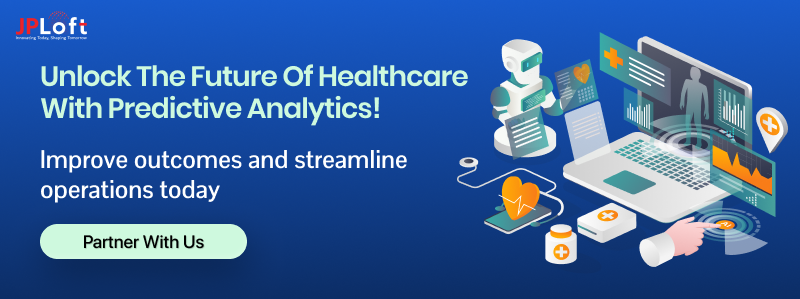
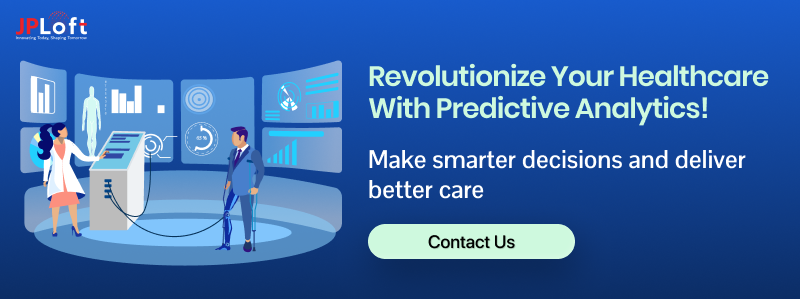


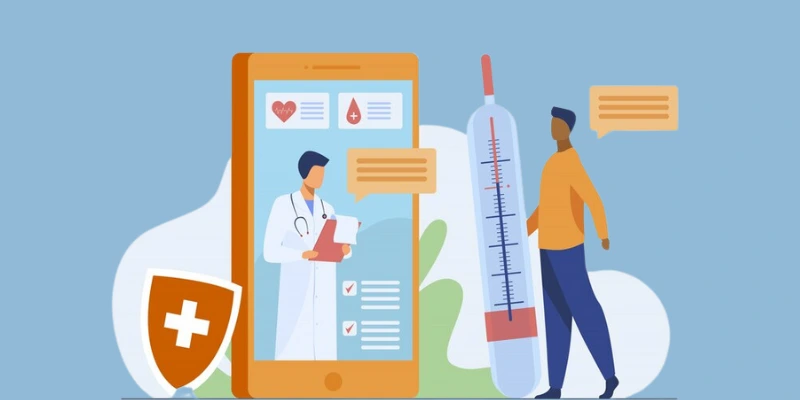
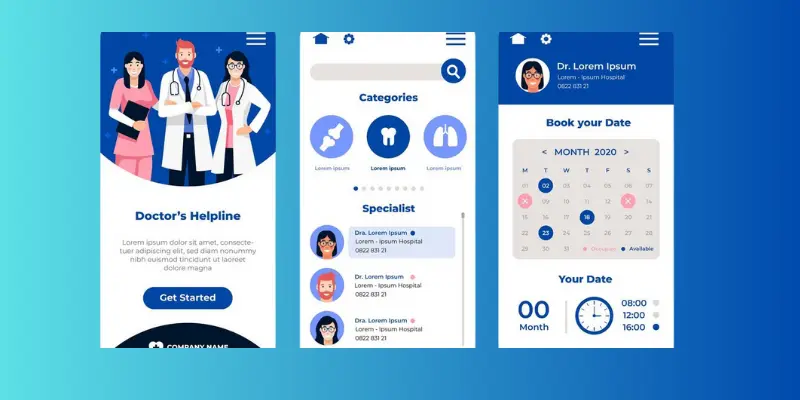



Share this blog